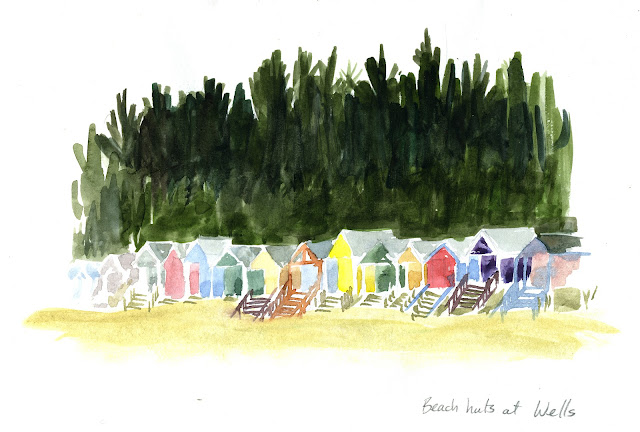Holkham to Wells
The next day I headed off
for the coast.
Driving up through north Norfolk really isn’t like driving anywhere else. There was only one smallish road all the way there, and the county isn’t criss-crossed with them like more urban or central counties are. I guess because there’s nowhere else to get to, just the sea. I always forget just how flat it is, and how far away the horizon is.
 |
| 20 min watercolour sketch of the salt marshes at Wells-next-the-sea |
Driving up through north Norfolk really isn’t like driving anywhere else. There was only one smallish road all the way there, and the county isn’t criss-crossed with them like more urban or central counties are. I guess because there’s nowhere else to get to, just the sea. I always forget just how flat it is, and how far away the horizon is.
I went to Holkham beach,
which is a little out of the way as most people go to nearby Wells-next-the-Sea
because there's more entertainment there for the kiddies - a train and some
arcades and so on. However the beach is more gravelly and ruled by the
tides, whereas Holkham's sand is light gold and soft.
You emerge out of a pine
wood onto an amazing expanse that leads down to the sea, framed by dunes and
fields of purple flowers. These are sea lavender, and in this area they
grow mainly here, and on the Salt Marshes around Wells.
(WARNING:
There's a coastal path running east along the side of the marshes if you ever
want to see them, which is the safest way. It you really must go
closer get an experienced guide who knows the area and the tides, and take
a phone with you. These are real marshes, complete with
quick-mud, and the channels between the dry areas make it difficult to navigate
back, particularly once the tide comes in and they start filling up again.
I had a guided walk here once and a friend decided to test the famous glue-like
mud. He's lucky he didn't put all his weight on it, but it took his shoe
right off.
Also,
mind the water near the Lifeboat station if you've got kids, inflatables or
aren't a strong swimmer. You should always be cautiously respectful of
any water, but the current in the beach-side channel is powerful during
tide-out and people have been swept out to sea from there. My family
visited the area a lot when I was younger, and we all knew about the current,
but I still had to go in after my brother once. The muppet.)
It was another
perfect day, cloudy but very warm, and within minutes my sandals were off and I
walked the couple of miles along the beach to Wells for a lunch of freshly
grilled mackerel in the Wells Crab House Cafe, caught that morning by The Boucher. Wells
was a major port in Tudor times, and still keeps a modest fishing fleet so
local food is easy to find.
Afterwards I sat on the seafront for a while, watching the holidaymakers fishing for crabs and let them go again, and then the sun finally came out as I began my trek back to the car at Holkham. I was hot enough that I decided to walk in the sea. I had spare clothes in my backpack so I was able to go in belly-deep and make my walk with cool salt water swelling round my waist, and getting some very peculiar looks from the beach. It was a lovely end to a quiet, restful, and adventurous day.
 |
| The sea lavender |














No comments:
Post a Comment